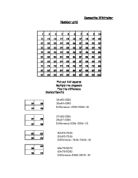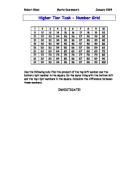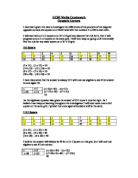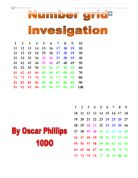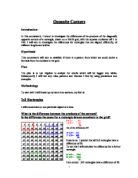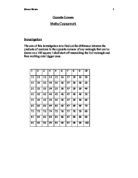Maths - number grid
Chapter One For the first part of my maths G.C.S.E coursework I have been provided with a 10x10 number grid, which is numbered 1 to 100. I have been instructed to find the product of the top left number and the bottom right number and the same with the top right and bottom left number within selected squares used. I am going to use this grid to examine at random various sizes of squares and rectangles. My objective here is to establish a trend to identify an overall formula. I am firstly going to examine a series of 2x2 squares the primary one I will look at has been outlined in the number grid I was provided with, I will then select alternative 2x2 squares at random from the grid. ) 13x22 - 12x23 286 - 276 Difference = 10 58x67- 57x68 2) 3886 - 3876 Difference = 10 3) 35x44 - 34x45 1540 - 1530 Difference = 10 By looking at the three 2x2 squares chosen above it is possible to see each time that there is a difference of 10. So in conclusion to this I can say that any further investigations using 2x2 squares will always result in a difference of 10. Looking at my results and the number grid at this stage, I feel I can suggest that the reason I may get the same result of 10 each time is one of two small theories, my first one being that it is possible to see that the
Number Grids Investigation Coursework
Number Grids Investigation Coursework In this coursework, I am going to investigate patterns in number grids as far as I can. It will be based around this number grid: 2 3 4 5 6 7 8 9 0 1 2 3 4 5 6 7 8 9 20 21 22 23 24 25 26 27 28 29 30 31 32 33 34 35 36 37 38 39 40 41 42 43 44 45 46 47 48 49 50 51 52 53 54 55 56 57 58 59 60 61 62 63 64 65 66 67 68 69 70 71 72 73 74 75 76 77 78 79 80 81 82 83 84 85 86 87 88 89 90 91 92 93 94 95 96 97 98 99 00 There is a 2 x 2 square highlighted: 3 4 23 24 I shall work out the difference between the products of opposite corners, i.e. this is the calculation I will use: (top right x bottom left) - (top left x bottom right) For example in the square highlighted the difference between the products in the opposite corners is: 14 x 23 - 13 x 24 = 10 2 x 2 Squares The above shows that, in one particular square, the difference between the products of the opposite corners is 10, so I shall now investigate some other examples to see if this is consistent in all 2 x 2 grids. 2 1 2 (top right x bottom left) - (top left x bottom right) = 2 x 11 - 1 x 12 = 22 - 12 = 10 67 68 77 78 (top right x bottom left) - (top left x bottom right) = 68 x 77 - 67 x 78 = 5236 - 5226 = 10 49 50 59 60 (top right x bottom left) - (top left x
Investigate different shapes in different sized number grids.
Introduction In this piece of course work I will investigate different shapes in different sized number grids. The shapes I will look at will be the square, the rectangle, the rhombus and the parallelogram. I will investigate these shapes in two different number grids, one a 10x10 grid and the other a 5x5 grid. I will draw these shapes on the number grids at random points and take the corner numbers and then multiply the opposite corners. From these results I will attempt to work out a formula for how the size of shape affects the result taken from the table. I will take the number from the bottom left corner of the shape and the top right corner of the shape and multiply these numbers together. This set of numbers will be represented by the colour RED. I will then take the top left corner and the bottom right corner and multiply these two numbers together. This set of numbers will be represented by the colour BLUE. I will then subtract the RED result from the BLUE which will give me the number I need to work out my formula. The number gained from the subtraction will be called the difference. All my results will be taken from either a 5x5 grid like this: 2 3 4 5 6 7 8 9 0 1 2 3 4 5 6 7 8 9 20 21 22 23 24 25 Or a 10x10 grid like this: 2 3 4 5 6 7 8 9 0 1 2 3 4 5 6 7 8 9 20 21 22 23 24 25 26 27 28 29 30 31 32 33 34
Number grid
Samantha Whittaker Number grid 2 3 4 5 6 7 8 9 0 1 2 3 4 5 6 7 8 9 20 21 22 23 24 25 26 27 28 29 30 31 32 33 34 35 36 37 38 39 40 41 42 43 44 45 46 47 48 49 50 51 52 53 54 55 56 57 58 59 60 61 62 63 64 65 66 67 68 69 70 71 72 73 74 75 76 77 78 79 80 81 82 83 84 85 86 87 88 89 90 91 92 93 94 95 96 97 98 99 00 Pick out 2x2 squares Multiply the diagonals Find the difference 34 35 44 45 INVESTIGATE 27 28 37 38 82 83 92 93 68 69 78 79 9 0 9 20 First number Second number Third number Fourth number stx4th 2ndx3rd Difference 34 35 44 45 530 540 0 27 28 37 38 026 036 0 82 83 92 93 7626 7636 0 68 69 78 79 5372 5382 0 9 0 9 20 80 90 0 I have put my results into a table so that they are easier to analyse and compare. What I have found is; when you take a 2x2 grid from a 10x10 grid, times the diagonals, the difference between the products of the diagonals is always 10. 36 37 46 47 If this rule is correct, then by using this grid: I predict that the difference between the Product of 36 and 47 compared with that of 37 and 46 will equal 10. 36x47=1692 37x46=1702 Difference=10 My prediction was correct as the difference between 36x47 (1692), and 37x46 (1702) was 10. To prove that this theory will work for any 2x2
Number Grid
Number Grid Coursework The grid I will using is a 10 x 10 grid, numbers ranging from 1 to 100. Grid Size = 10 x 10 Box size = 2 x 2 Task 1: I will take a 2 x 2 box on the 100 numbered grid and I will find the product of the top left number and the bottom right number of this box, and will do the same with the top right and bottom left numbers of this box. I will then look at the relationship between the two products, by finding the difference. 2 3 22 23 2 x 23 = 276 3 x 22 = 286 286-276 = 10 Difference = 10 Now I want to find out whether or not the difference of these two products is constant throughout the number grid, therefore I will randomly move the box somewhere else: 78 79 88 89 78 x 89 = 6942 79 x 88 = 6952 6952-6942 = 10 Difference = 10 I want to further test out the experiment: 55 56 65 66 55 x 66 = 3630 56 x 65 = 3640 3640-3630 = 10 Difference = 10 I will now represent all the numbers in the box with a letter, therefore the first letter in the box (left- top corner) will be a: a b c d Table of results: a ad bc bc-ad 2 276 286 0 78 6942 6952 0 55 3630 3640 0 39 950 960 0 7 26 36 0 From the results of this experiment, I have come to realize that there is a distinct pattern in the results. From the results, this suggests that the difference between the products of ad and bc is always 10. One can also see
Number grid Investigation
2 3 4 5 6 7 8 9 0 1 2 3 4 5 6 7 8 9 20 21 22 23 24 25 26 27 28 29 30 31 32 33 34 35 36 37 38 39 40 41 42 43 44 45 46 47 48 49 50 51 52 53 54 55 56 57 58 59 60 61 62 63 64 65 66 67 68 69 70 71 72 73 74 75 76 77 78 79 80 81 82 83 84 85 86 87 88 89 90 91 92 93 94 95 96 97 98 99 00 For my coursework on investigation I have chosen to use a number grid. From the grid I will draw a box around a selected amount of numbers I will then find the product of the top left number and the bottom right number this will be repeated with the top right number and the bottom left number. When this is completed I will then find the difference between the two numbers. During this process I will be looking for patterns in and relationships between the differences that I collect. The grid that I have started with is numbered from 1 to 100 with ten in each row and ten in each column. 2 3 22 23 I drew a box around four numbers and then found the product of the top left number: 2 x 23 = 276 I then repeated this with the top right number and the bottom left number: 3 x 22 =286 On completion of this I found the difference: 286 - 276 = 10 I repeated this process four times with other numbers from the grid to see if the difference would change. 62 63 72 73 62 x 73 = 4526 63 x 72 = 4536
Number Grid Investigation.
Number Grid Investigation 2 3 4 5 6 7 8 9 0 1 2 3 4 5 6 7 8 9 20 21 22 23 24 25 26 27 28 29 30 31 32 33 34 35 36 37 38 39 40 41 42 43 44 45 46 47 48 49 50 51 52 53 54 55 56 57 58 59 60 61 62 63 64 65 66 67 68 69 70 71 72 73 74 75 76 77 78 79 80 81 82 83 84 85 86 87 88 89 90 91 92 93 94 95 96 97 98 99 00 Task. My task is to use the box above to do the following things: * Draw a box around 4 numbers. * Find the product of the top left number and the right number within this box. * Do the same with the top right and the bottom left numbers. * Calculate the difference between these products. * INVESTIGATE FURTHER... This assignment is concerned with product differences in different size matrices for different sized grids. Above is a 10 X 10 grid. We are trying to investigate product differences within this 10 X 10 grid. As you can see I have drawn a 2 X 2 grid inside the 10 X 10 matrix. To find the product difference I do: Top left number X bottom right - top right X bottom left. TL X BR - TR X BL TL = Top left BR = Bottom right TR = Top right BL = Bottom left. The product difference I found was 10. This was anywhere on the grid where a 2 X 2 grid could be drawn. To prove this I will take a 2 X 2 grid and use the above formula to work out the product difference.
Number Grid Coursework
Maths Investigation 1 Higher Tier Task - Number Grid Section 1: 2x2 Box on Width 10 Grid ) Introduction I was given a number grid, like the one in Fig 1.1. The task was to, in the 2x2 box, find the product of top-left (TL) and bottom-right (BR) numbers, and the product of the top-right (TR) and bottom-left (BL) numbers and then to calculate the difference of these two products. 2 3 4 5 6 7 8 9 0 1 2 3 4 5 6 7 8 9 20 21 22 23 24 25 26 27 28 29 30 31 32 33 34 35 36 37 38 39 40 41 42 43 44 45 46 47 48 49 50 51 52 53 54 55 56 57 58 59 60 61 62 63 64 65 66 67 68 69 70 71 72 73 74 75 76 77 78 79 80 81 82 83 84 85 86 87 88 89 90 91 92 93 94 95 96 97 98 99 00 Fig 1.1 This calculation rule was to be followed throughout the investigation. Having done this, I found the difference of the two products to be 10 and I wondered what would happen if the box was placed in other locations on the grid. 2) Method To discover this, I will calculate the difference of the two products for 5 different random locations of the box within the grid. As it would be impractical (and impossible if the grid extended to more than 10 rows) to do all possible calculations, 5 should be enough to display any patterns that may lie therein. 3) Data Collection Here are the results of the 5 calculations for 2x2
Investigate the differences between products in a controlled sized grid.
Aim I am going to investigate the differences between products in a controlled sized grid. Method I am going to keep the grid size the same. Keeping the number of rows and columns the same. I am going to change the position of the box and the size of the size of the box altering the number of rows and columns. Investigation on 2by 2 boxes in a 10 by 10 grid. 2 3 4 5 6 7 8 9 0 1 2 3 4 5 6 7 8 9 20 21 22 23 24 25 26 27 28 29 30 31 32 33 34 35 36 37 38 39 40 41 42 43 44 45 46 47 48 49 50 51 52 53 54 55 56 57 58 59 60 61 62 63 64 65 66 67 68 69 70 71 72 73 74 75 76 77 78 79 80 81 82 83 84 85 86 87 88 89 90 91 92 93 94 95 96 97 98 99 00 I am now going to multiply opposite numbers together in the box. This is to show the differences. 2 1 2 *12=12 1*2=22 DIFFERENCE=10 9 0 9 20 9*20=180 9*100=190 DIFFERENCE=10 36 37 46 47 36*47=1692 37*46=1702 DIFFERENCE=10 Table of results 2 1 2 9 0 9 20 A B A B C D C D 36 37 46 47 A B C D I have called these numbers A, B, C, D so that it will be easier to see the results in the table. It will also be easier to see which numbers I am going to multiply together. Number A Number B Number C Number D Product of A*D Product of B*C Product of A*D- product of B*C 2 1 2 2 22 0 9 0 9 20 80 90 0 36
Number Grid
Higher Tier Task - Number Grid 2 3 4 5 6 7 8 9 0 1 2 3 4 5 6 7 8 9 20 21 22 23 24 25 26 27 28 29 30 31 32 33 34 35 36 37 38 39 40 41 42 43 44 45 46 47 48 49 50 51 52 53 54 55 56 57 58 59 60 61 62 63 64 65 66 67 68 69 70 71 72 73 74 75 76 77 78 79 80 81 82 83 84 85 86 87 88 89 90 91 92 93 94 95 96 97 98 99 00 Use the following rule: find the product of the top left number and the bottom right number in the square. Do the same thing with the bottom left and the top right numbers in the square. Calculate the difference between these numbers. INVESTIGATE! I will begin with 2x2 windows on a 10x10 grid. 2 3 4 5 6 7 8 9 0 1 2 3 4 5 6 7 8 9 20 21 22 23 24 25 26 27 28 29 30 31 32 33 34 35 36 37 38 39 40 41 42 43 44 45 46 47 48 49 50 51 52 53 54 55 56 57 58 59 60 61 62 63 64 65 66 67 68 69 70 71 72 73 74 75 76 77 78 79 80 81 82 83 84 85 86 87 88 89 90 91 92 93 94 95 96 97 98 99 00 34 x 25 = 850 49 x 58 = 2842 24 x 35 = 840- 48 x 59 = 2832- 10 10 88 x 97 = 8536 63 x 72 = 4536 87 x 98 = 8526- 73 x 62 = 4526- 10 10 3 x 12 = 36 6 x 15 = 90 2 x 13 = 26- 5 x 16 = 80- 10 10 For all of these windows you can





